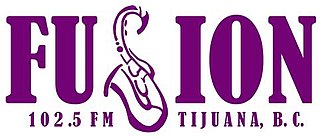Related Research Articles
XHRF-FM and XERF-AM are radio stations in Ciudad Acuña, Coahuila, Mexico. Originally only on the AM band, XERF is a Mexican Class A clear-channel station transmitting with 100,000 watts of power. Now branded as La Poderosa, XHRF-FM and XERF-AM simulcast their programming and are owned by the Instituto Mexicano de la Radio (IMER), a Mexican public broadcaster.

XERA is a radio station in Mexico, broadcasting on 760 AM in San Cristóbal de las Casas, Chiapas, Mexico. The station's callsign was most famous for its use on a border blaster at Villa Acuña, Coahuila.

XHUAN-FM is a public radio station licensed to Tijuana, Baja California, owned by IMER, Mexico's public radio network. Like the public radio stations in the United States, IMER presents a variety of discussion and music programs.
XHOF-FM, also known as Reactor 105.7, is a radio station in Mexico City that plays alternative rock music, and hip hop mainly in English and Spanish. Its broadcast frequency is 105.7 MHz.
XEITE-AM is a radio station in Mexico City, broadcasting on 830 kHz. The station is owned by Capital Media.
XHLAC-FM is a Mexican radio station in Lázaro Cárdenas, Michoacán. Broadcasting on 99.7 FM, XHLAC-FM is owned by the Instituto Mexicano de la Radio and broadcasts a music and information format under the name "Radio Azul".
Radio México Internacional is a Mexican government-run radio service based in Mexico City. It broadcast as a shortwave radio station with the broadcast callsign XERMX-OC from 1969 to 2004, and was relaunched as an Internet-only radio service in 2011. Since 1983, it has been under the control of the Instituto Mexicano de la Radio (IMER). The -OC suffix is from onda corta, Spanish for "short wave".

The Instituto Mexicano de la Radio is a Mexican public broadcaster, akin to National Public Radio in the US. It is also known as IMER.

XEB-AM is a radio station on AM frequency 1220 kHz, serving Mexico City and surrounding areas in Mexico. Under the brand name La B Grande, the station airs a Spanish-language classic contemporary format with music from the 1940s to the 1970s. It has been owned by the Instituto Mexicano de la Radio (IMER), a Mexican government public broadcaster, since IMER's founding in 1983.
XHIMER-FM is a radio station in the Mexican capital Mexico City. The station is owned by the Instituto Mexicano de la Radio (IMER) and broadcasts a classical music format under the brand name Opus 94 from a tower on Cerro del Chiquihuite.
XHIMR-FM is a radio station in Mexico City. Broadcasting on 107.9 FM from a tower in Ajusco, XHIMR is owned by the Instituto Mexicano de la Radio and broadcasts a jazz music format under the brand name Horizonte 107.9.
XEDTL-AM is a radio station in the Mexican capital Mexico City. Broadcasting on 660 AM, XEDTL-AM is owned by the Instituto Mexicano de la Radio and broadcasts a tropical music format under the brand name Tropicalísima.

XEMP-AM is a radio station in the Mexican capital Mexico City. Broadcasting on 710 AM, XEMP-AM is owned by the Instituto Mexicano de la Radio and broadcasts a regional Mexican format under the name Radio 710.
XHFQ-FM is a Mexican radio station in Cananea, Sonora. Broadcasting on 103.1 FM, XHFQ is owned by the Instituto Mexicano de la Radio and broadcasts a varied music format under the name "La FQ".

XHCAH-FM is a radio station in Cacahoatán, Chiapas, Mexico. Broadcasting on 89.1 FM, XHCAH-FM is owned by the Instituto Mexicano de la Radio and broadcasts a music and information format under the name "La Popular".

XHCHZ-FM is a radio station in Chiapa de Corzo, Chiapas, Mexico. Broadcasting on 107.9 FM, XHCHZ-FM is owned by the Instituto Mexicano de la Radio and broadcasts a music and information format under the name "Radio Lagarto".

XHSCO-FM is a radio station in Salina Cruz, Oaxaca, Mexico. Broadcasting on 96.3 FM, XHSCO-FM is owned by the Instituto Mexicano de la Radio and broadcasts a news and music format under the name "Estéreo Istmo".

XHEMIT-FM 94.9 is a radio station in Comitán, Chiapas, Mexico. Broadcasting on 94.9 FM, XHEMIT-FM is owned by the Instituto Mexicano de la Radio and broadcasts a music and information format under the name "Radio IMER".
XHIRC-FM is a radio station serving Colima, Colima, in central−western Mexico. The station is owned by the state of Colima through the Instituto Colimense de Radio y Televisión and broadcasts on 98.1 MHz.

Radio in Mexico is a mass medium with 98 percent national penetration and a wider diversity of owners and programming than on television. In a model similar to that of radio in the United States, Mexican radio in its history has been largely commercial, but with a strong state presence and a rising number of noncommercial stations in the 2000s and early 2010s. In August 2015, there were 1,999 legal radio stations, almost 75 percent of them on the FM band.
References
- ↑ Instituto Federal de Telecomunicaciones. Infraestructura de Estaciones de Radio AM. Last modified 2018-05-16. Retrieved 2014-12-18. Technical information from the IFT Coverage Viewer.
- 1 2 3 4 5 6 7 IMER: XEQK History
- 1 2 3 "IMER: History of La Hora Exacta". Archived from the original on 2017-03-02. Retrieved 2014-12-18.
- ↑ "La voz de la hora exacta en México
- ↑ "La muchedumbre contra Toño Esquinca | 24 Horas". Archived from the original on 2014-12-19.